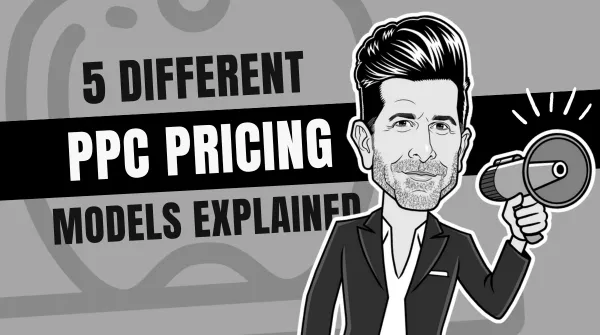5 Different PPC Pricing Models Explained
PPC advertising is an effective way of driving traffic and sales to your website. However, choosing the right pricing model can be a daunting task. Different PPC pricing models have their advantages and disadvantages, and it’s crucial to understand them before deciding which one to use. In this article, we’ll explore five different PPC pricing models and help you choose the one that fits your business needs.
Different PPC Pricing Models
If you’re not familiar with the various ways to pay for cost per click services, a few different pay per click models include the following:
- Per Keyword Phrase Bid per PPC Account
- Percentage of Ad Spend
- Hourly Rate
- Pay for Performance
- Flat-rate PPC
Per Keyword Phrase Bid Per PPC Account
In this model, the PPC management firm or company charges you a monthly fee. This is based on the number of keywords managed for each of your pay per click accounts.
For instance, the company charges $15 per month per keyword bid per account. The company manages 100 keywords in Google Adwords and 75 keywords in Yahoo Search Marketing. Then, the management fee is $2,625 (100 keywords + 75 keywords x $15 per month).
This seems to be a pretty equitable model. One downside is your costs increase as you add more keyword phrases. The additional costs may prevent some companies from seeking “long-tail” keywords. They may not generate a lot of traffic, but may convert very well. A number of low-traffic, high-conversion keyword phrases can add significant profits to your ad click campaign.
Percentage of Ad Spend
This is the traditional advertising agency model. Pay per click management fees are assessed based on how much the PPC account spends. Most PPC agencies or companies charge fees that range between 15%-30% of your total PPC ad spends.
If you spend $10,000 each month with Google AdWords and Microsoft adCenter. The pay per click advertising agency charges 25% of your total ad spend. Their fee would be $2,500.
The percentage of ad spend model is a pricing model that involves paying a percentage of your total ad spend to the PPC agency. This model is ideal for businesses that want to outsource their PPC management and have a flexible marketing budget.
The percentage of ad spend model is useful for businesses that want to work with a PPC agency. But don’t want to commit to a fixed price. This model is also ideal for businesses that want to have control over their budget and understand the cost of their PPC campaign.
The major drawback to the percentage spend model is that it may not encourage your PPC provider to manage your ad budget effectively. In fact, the model may encourage some pay per click providers to spend more. As their management fee is tied to the ad spend – not performance.
Hourly Rate
Many professional service firms choose to use the hourly rate model. The pay per click campaign management company charges you based on the amount of time they spend managing your account each month.
If they charge an hourly rate of $100 per hour and work 15 hours on managing your click campaign, you are billed $1,500.
The age-old flaw in the hourly rate model is that it encourages “less-than-honest” PPC management companies to be inefficient. More hours for them equals more costs for you.
Pay for Performance
In a pay for performance model, you pay the PPC management company a predetermined fee per established metric. For instance, you may pay the company $5.00 for each phone call or email you receive from the campaign. Or, you could pay them 5% of each sale generated from the PPC campaign they manage for you. There are numerous options available under this model.
The biggest downside to the pay for performance model is the difficulty in determining a metric that can be easily and accurately tracked. Or one the PPC campaign management company has total, or at least significant, control over.
For instance, one metric could be a fixed fee per conversion. One critical piece of a conversion is the landing page copy, design and call to action. If the click management company cannot control this aspect of the conversion this metric is not used for billing purposes.
Flat-rate PPC
A flat-rate PPC model is usually straightforward for both parties. Once the scope of a PPC consulting service or advertising management has been defined, a project or monthly-based fee is assessed.
The flat-rate PPC model is a pricing model that involves negotiating a fixed price for a specific amount of clicks or impressions. This model is ideal for businesses that have a limited budget and want to know exactly how much they will be spending on their PPC campaign.
The flat-rate PPC model is useful for businesses that want to have control over their budget and understand the cost of their PPC campaign. This model is also ideal for businesses that have a clear idea of how many clicks or impressions they need to achieve their goals.
The drawback with the flat-rate PPC model occurs when the scope of PPC management activities is not clearly defined. Whether the fee includes a specific activity or not, people raise questions.

Different PPC Pricing Models the Secret Formula
Choosing the right PPC pricing model can be challenging. However, understanding the different PPC pricing models available can help you make an informed decision. The models all have their advantages and disadvantages, and it’s crucial to understand them before deciding which one to use. Whether you want to increase website traffic, create brand awareness or focus on conversions. There’s a PPC pricing model that can help you achieve your goals.





Leave a Reply
Want to join the discussion?Feel free to contribute!